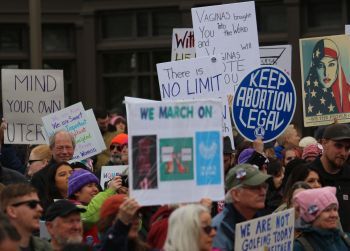
Publisher:
Bonnie King
CONTACT:
Newsroom@Salem-news.com
Advertising:
Adsales@Salem-news.com

~Truth~
~Justice~
~Peace~
TJP
Jan-20-2022 15:31

 TweetFollow @OregonNews
TweetFollow @OregonNews
Oregon Protects and Expands Access to Legal Abortion
Salem-News.comOn the 49th, and possibly final, Anniversary of Roe v. Wade, Oregon is protecting and expanding access to abortion.
 Women's March in Salem, Oregon (Jan 2019) Photo by Christian King, Salem-News.com |
(SALEM, Ore.) - Saturday, January 22nd will mark the 49th anniversary of Roe v. Wade. At a time when abortion access is systematically being dismantled across the nation and reproductive rights are at risk like never before, Oregon is one of the few states in the country continuing to protect and expand access to abortion.
The U.S. Supreme Court has already allowed the decimation of abortion access in Texas and green-lit the unraveling of abortion protections around the nation.
With the court considering a case that could officially erase nearly 50 years of precedent and the constitutional right to abortion, abortion access could be at risk in more than half the states in the country.
In Oregon, state legislators protected and expanded abortion access by passing 2017’s Reproductive Health Equity Act, which safeguards abortion rights in Oregon no matter what happens to Roe.
Yet the legal right to an abortion has never been enough when millions can’t access it. For so many, including some Oregonians, abortion is a right in name only. That is why Oregon continues to push beyond legal protection to enact policies that expand and ensure access to safe, quality reproductive health care.
Last year Oregon passed the Telehealth Equity Act, which ensures coverage of telehealth services so Oregonians can access health care no matter where they are, and the Equal Access to Care Act, which protects access to essential health services, including reproductive health care, during mergers and acquisitions.
Less than two months ago, a majority of Supreme Court justices appeared prepared to overturn Roe during oral arguments in a case on a Mississippi abortion ban where the state explicitly requested the constitutional right be overturned.
Should Roe be overturned, by this summer, politicians in about half of U.S. states may be able to control people’s personal reproductive decisions.
“Access to abortion should not depend on your ZIP code. As safe and legal abortion access is under attack all across the country, Planned Parenthood health centers in Oregon are continuing to provide patients with expert, compassionate abortion care," said Lisa Gardner, President & CEO, Planned Parenthood of Southwestern Oregon.
"We will continue providing care to all patients in our communities and those who travel to our state to access the abortion care they deserve.”
About 36 million women — nearly half of the women of reproductive age (18-49) in the United States and more people who can become pregnant — could lose access to abortion.
“By this summer, the Supreme Court could officially erase nearly 50 years of precedent and gut the constitutional protections that millions rely on to legally access an abortion," said An Do, Executive Director, Planned Parenthood Advocates of Oregon.
"Whether or not the Supreme Court explicitly overturns Roe v. Wade, we know that the right to an abortion has never been enough to guarantee access.
"We cannot be complacent. We must continue fighting for proactive measures to protect and expand abortion access across the country, and the U.S. Senate must follow the lead of our Oregon leaders, take action and pass the Women’s Health Protection Act as soon as possible.”
Last year, in a historic vote, the U.S. House of Representatives passed the Women’s Health Protection Act (WHPA) with the support of Oregon Congresswoman Suzanne Bonamici, Congressman Peter DeFazio, Congressman Earl Blumenauer and Congressman Kurt Schrader.
WHPA establishes a statuatory right to provide and receive abortion care, prohibiting states from implementing abortion bans and restrictions.
The U.S. Senate must follow suit and pass WHPA as soon as possible to ensure everyone can make their own healthcare decisions without political interference.
Roe at Risk: Oregon Impact Report
With the U.S. Supreme Court poised to rule on a case that could render the constitutional right to an abortion meaningless, recent research from Planned Parenthood Federation of America and In Our Own Voice: National Black Women’s Reproductive Justice Agenda shows that nearly half of the women in the United States of reproductive age — more than 36 million women — and more people who can become pregnant, could lose abortion access if Roe v. Wade is overturned.Dobbs v. Jackson Women’s Health Organization, a petition to uphold Mississippi’s cruel 15-week abortion ban, could hollow out Roe and upend nearly 50 years of precedent.
In fact, the state of Mississippi is asking the court to overturn both Roe v. Wade (1973) and Planned Parenthood v. Casey (1992), which would pave the way for 26 states to quickly move to ban abortion.

Idaho is among 12 states with "trigger laws" that state governments could use to ban abortion immediately after a Supreme Court decision overruling or undermining Roe. Oregonians would be directly harmed as a result:
- An analysis in The New York Times indicates that Eastern Oregonians could see a 35% reduction in abortion access, forced to drive hundreds of miles to the nearest provider in Bend.
- A study by The Guttmacher Institute indicates that Oregon health centers would experience a 234% increase in out-of-state patients if a 15-week abortion ban goes into effect.
- Oregon health centers are already experiencing staffing shortages. In a post-Roe world, there would be real impacts for Oregonians who may have trouble getting appointments in their own communities.
For far too many people, abortion is nearly inaccessible due to a shortage of abortion providers, lack of insurance coverage and an onslaught of draconian and medically unnecessary state restrictions — including mandatory waiting periods, forced ultrasounds, biased counseling, bans on safe abortion methods and telemedicine bans.
“Planned Parenthood health centers are utilizing technology and innovation to continue increasing access to medication abortion care through telehealth," said Anne Udall, President & CEO, Planned Parenthood Columbia Willamette.
"Studies have shown that medication abortion is as safe and effective as medical abortions conducted in person. Still, there is more work to be done, especially to ensure access for those facing systemic barriers to care — Black, Brown and Native communities; LGBTQ+ people; people in rural areas; and those struggling to make ends meet.”
- The 36 million people who would lose access to abortion if Roe is overturned include 5.3 million Black people, 5.7 million Hispanic or Latino people, 1.1 million Asian people and nearly 340,000 American Indian or Alaska Native people of reproductive age (American Community Survey 2019).
- Those who receive abortions are 39% white, 28% Black, 25% Hispanic and 6% AAPI.
- In 2019, nearly 1 in 9 women across the country lived in poverty — and those were disproportionately Black, Latina or Indigenous women, who experience poverty at twice the rate of non-Hispanic white women due to economic disparities rooted in racist policies.
- Groups facing discrimination and systemic oppression in the healthcare system are more likely to have low incomes and more likely to use Medicaid — including people of color, LGBTQ+ people, people with disabilities and women. These insurance programs may not use federal funds to cover abortion because of the Hyde Amendment, a discriminatory restriction in effect for more than 40 years. The majority of abortion patients are forced to pay out-of-pocket for the procedure, which averages around $500 — a significant and unexpected expense for people with low incomes.
- The vast majority of abortion patients (75%) are people with low incomes, and 49% earn below the federal poverty level (a family of two earning an annual income of $15,730 or less).
- Access to abortion hinges not just on navigating the financial cost, but on managing logistical barriers like child care, time off work and travel.
THE BOTTOM LINE:
THE THREAT TO THE CONSTITUTIONAL RIGHT TO AN ABORTION HAS NEVER BEEN GREATER. Abortion justice can only be achieved when people have the complete economic and social power and resources to make healthy decisions about their bodies, families and communities in all areas of their lives.
It is time to depoliticize what should be a personal healthcare decision, support abortion access in all communities and support policies that increase access to abortion — rather than decimating people’s most basic rights, city by city and state by state.
Source(s): News Release from Planned Parenthood Advocates of Oregon; State of Oregon
Articles for January 19, 2022 | Articles for January 20, 2022 |
Salem-News.com:


Quick Links
DINING
Willamette UniversityGoudy Commons Cafe
Dine on the Queen
Willamette Queen Sternwheeler
MUST SEE SALEM
Oregon Capitol ToursCapitol History Gateway
Willamette River Ride
Willamette Queen Sternwheeler
Historic Home Tours:
Deepwood Museum
The Bush House
Gaiety Hollow Garden
AUCTIONS - APPRAISALS
Auction Masters & AppraisalsCONSTRUCTION SERVICES
Roofing and ContractingSheridan, Ore.
ONLINE SHOPPING
Special Occasion DressesAdvertise with Salem-News
Contact:AdSales@Salem-News.com
googlec507860f6901db00.html

Terms of Service | Privacy Policy
All comments and messages are approved by people and self promotional links or unacceptable comments are denied.
[Return to Top]
©2025 Salem-News.com. All opinions expressed in this article are those of the author and do not necessarily reflect those of Salem-News.com.